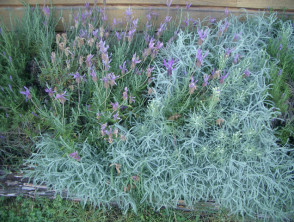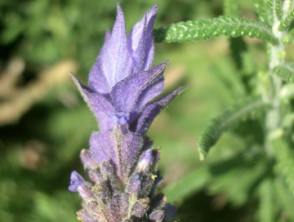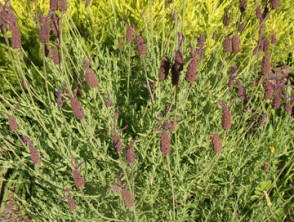| Common name: | Lavender (to wash) |
| Botanical name: | Lavandula officinalis |
| Family: | Lavandula species {Lamiaceae or mint family} |
| Origin: | These perennials were found originally wild in the Mediterranean region. The original name comes from the Latin, to wash. |
| Description: | Lavender belongs to a genus of 28 species of hardy evergreen shrubs. Two of the more common species are English lavender (Lavendula officinalis) and French lavender (L. stoechas).The different varieties of this plant range in height from 20 cm to 1 meter in height, although some may grow taller with age. They have thin leaves and many long spikes of lavender or purple flowers that grow up from the leaf axils. |
| Uses: | The flowers and the foliage of lavender are sweet smelling and may be used dried or fresh. They produce fragrant oil that is extracted for commercial use. Hybrids developed specifically for this purpose have a high lavender-oil content and are known as lavandins. Lavender has been used for hundreds of years in sachets, potpourris and linens and to give a light flavour to fruit dishes, sauces, cordials, and confections. Fresh sprigs are included in herbal bunches known as tussie mussies, which have been used for hundreds of years to mask unpleasant odours and ward off illness. |
| Allergens: | The allergens in lavender oil are geraniol, linalool, linalylacetate and are well recognised in causing allergic contact dermatitis. The usual exposure to lavender is from cosmetics and fragrances containing lavender oil. However, a recent study from Japan demonstrated that 4% of patients (with cosmetic allergy) were sensitive to lavender oil. The rate of allergy increased suddenly in 1997, associated with an increase in the practice of aromatherapy. Allergy to lavender oil has also been reported following contact with a variety of medicate creams such as Difflam® gel and Phenergan® cream which contain lavender oils. |
| Allergy: | Lavender oil (aroma therapy), Difflam gel, Phenergan cream. There do not appear to be any reports of systemic reactions due to ingestion of lavender although there are such reports following eating of both oregano and thyme, which belong to the same family. |
| Cross reactions: | |
| Other information: | |
| Patch test: | lavender oil 5% in petrolatum; 30% linalool, 10% geraniol, 10% linalyacetate |


